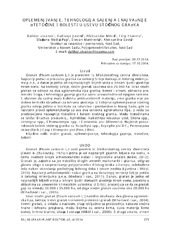Приказ основних података о документу
Breeding, technology practices and the most important pests and diseases in the field pea crop
Oplemenjivanje, tehnologija gajenja i najvažnije štetočine i bolesti u usevu stočnog graška
| dc.creator | Živanov, Dalibor | |
| dc.creator | Jevtić, Radivoje | |
| dc.creator | Mikić, Aleksandar | |
| dc.creator | Franeta, Filip | |
| dc.creator | Medić-Pap, Slađana | |
| dc.creator | Maširević, Stevan | |
| dc.creator | Savić, Aleksandra | |
| dc.date.accessioned | 2021-04-26T19:13:38Z | |
| dc.date.available | 2021-04-26T19:13:38Z | |
| dc.date.issued | 2014 | |
| dc.identifier.issn | 0354-6160 | |
| dc.identifier.uri | http://fiver.ifvcns.rs/handle/123456789/1369 | |
| dc.description.abstract | Pea (Pisum sativum L.) originated from the Middle East. The oldest data of its presence on the territory of Serbia originate from the forth millennium B.C. Today is one of the most important plant species in human and animal diet around the world. On the territory of Serbia, cultivated area of field pea is estimated of 20000 ha. The term field pea refers to two agricultural types, namely forage pea and dry or protein pea. Thus, technology practices depend on its purpose. Since it contains small amounts of anti-nutritional compounds, it is not necessary to thermally process the grains of pea for animal nutrition. Field pea breeding in Serbia is ongoing only in the Institute of Field and Vegetable Crops in Novi Sad, where breeding directions for these two agricultural field pea types are carried out since its establishment in 1938. This paper also presents the most important pests and diseases of field pea. Among pests, the most damaging are Bruchus pisorum L., Aphididae, Kakothrips robustus Uzel, Sitona spp., Liriomyza spp., Chromatomyia spp. and Contarinia pisi (Winnertz). The most important pathogens of field pea are Ascochyta spp., Erysiphe pisi DC., Peronospora viciae (Berk.) Casp and Uromyces pisi (Pers.) Wint. | en |
| dc.description.abstract | Grašak (Pisum sativum L.) je poreklom iz bliskoistočnog centra diverziteta. Najstariji podaci o prisustvu graška na teritoriji Srbije datiraju iz četvrtog milenijuma p.n.e., a danas je jedna od najznačajnijih biljnih vrsta u ishrani ljudi i životinja širom sveta. Na teritoriji Srbije, stočni grašak zauzima oko 20.000 ha. Izraz stočni grašak se odnosi na dva agronomska tipa graška, krmni i zrneni, odnosno proteinski. Stoga, i tehnologija gajenja graška zavisi prevashodno od njegove namene. S obzirom da sadrži malu količinu antinutritivnih materija, zrno graška nije potrebno termički obrađivati za ishranu životinja. U Srbiji se oplemenjivanje stočnog graška odvija jedino u Institutu za ratarstvo i povrtarstvo iz Novog Sada, gde su razvijeni pravci oplemenjivanja za ova dva osnovna agronomska tipa. U radu su predstavljene najvažnije štetočine i bolesti stočnog graška. Među štetočinama se ističu: Bruchus pisorum L., Aphididae, Kakothrips robustus Uzel, Sitona spp., Liriomyza spp., Chromatomyia spp. i Contarinia pisi (Winnertz). Najčešći prouzrokovači bolesti stočnog graška su Ascochyta spp., Erysiphe pisi DC., Peronospora viciae (Berk.) Casp i Uromyces pisi (Pers.) Wint. | sr |
| dc.publisher | Univerzitet u Novom Sadu - Poljoprivredni fakultet - Departman za zaštitu bilja i životne sredine "dr Pavla Vukasovića", Novi Sad | |
| dc.relation | info:eu-repo/grantAgreement/MESTD/Technological Development (TD or TR)/31024/RS// | |
| dc.rights | openAccess | |
| dc.source | Biljni lekar | |
| dc.subject | field pea | en |
| dc.subject | breeding | en |
| dc.subject | technology practices | en |
| dc.subject | pests | en |
| dc.subject | diseases | en |
| dc.subject | stočni g rašak | sr |
| dc.subject | oplemenjivanje | sr |
| dc.subject | tehnologija gajenja | sr |
| dc.subject | štetočine | sr |
| dc.subject | bolesti | sr |
| dc.title | Breeding, technology practices and the most important pests and diseases in the field pea crop | en |
| dc.title | Oplemenjivanje, tehnologija gajenja i najvažnije štetočine i bolesti u usevu stočnog graška | sr |
| dc.type | article | |
| dc.rights.license | ARR | |
| dc.citation.epage | 285 | |
| dc.citation.issue | 4 | |
| dc.citation.other | 42(4): 273-285 | |
| dc.citation.rank | M52 | |
| dc.citation.spage | 273 | |
| dc.citation.volume | 42 | |
| dc.identifier.fulltext | http://fiver.ifvcns.rs/bitstream/id/311/1366.pdf | |
| dc.identifier.rcub | https://hdl.handle.net/21.15107/rcub_fiver_1369 | |
| dc.type.version | publishedVersion |


